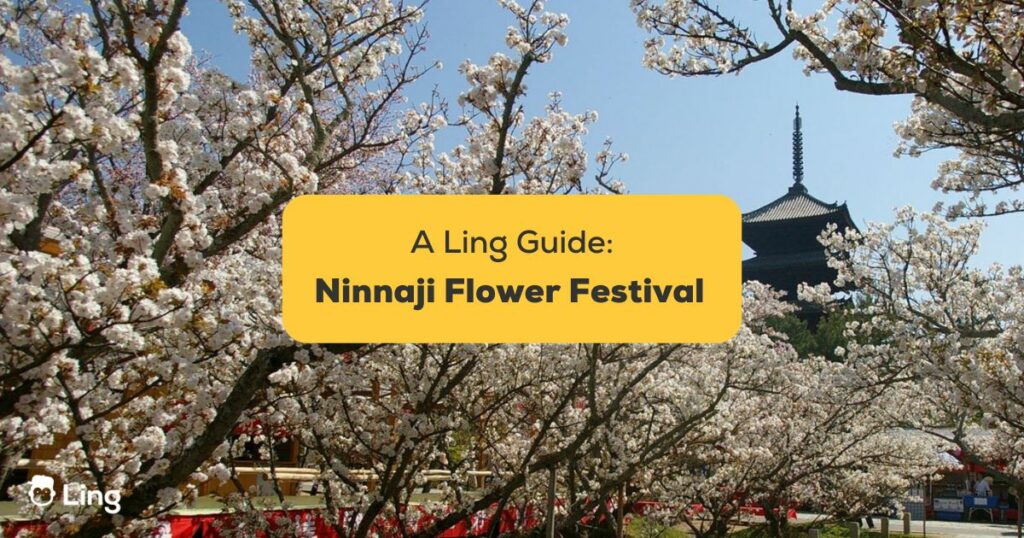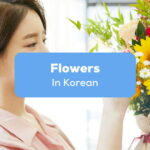We all know that it’s a great time to visit Japan during cherry blossom season. After all, it’s not every day that you get to be surrounded by such spring beauty, where cherry blossoms are all in full bloom. And did you know there are festivals specially dedicated to the beloved national flower? Ninnaji Flower Festival is just one of the many festivals in Japan!
Enter Ninnaji Flower Festival (仁和寺花祭り). Ninnaji (仁和寺) refers to Ninnaji Temple, where this festival is held. Hana (花) means “flowers,” while Matsuri (祭り) means “festival” in Japanese. Put together, it’s the Ninnaji Flower Festival.
In this guide, I’ll be taking you beyond simply admiring the spring beauty by telling you more about this fantastic festival. And while I’m add it, I’ll be teaching you some simple Japanese phrases as well! They might come in handy if you decide to visit Kyoto.
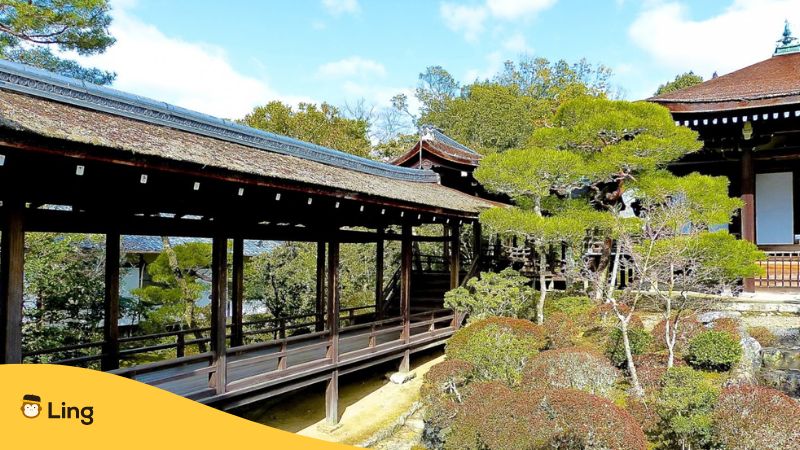
What Is The Ninnaji Flower Festival?
Ninnaji Flower Festival is basically cherry blossom viewing, or 花見 (Hanami), at the temple grounds of the famous Ninnaji Temple, which is located in Kyoto (京都). This festival takes place during cherry blossom season, which is mid-March to mid-April. The standard Somei Yoshino (染井吉野) variety of cherry trees may be beautiful, but do you know what’s even more special? The temple’s very own cherry blossom variety, of course!
These cherry blossoms are called Omuro Sakura (御室桜). Unlike their Somei Yoshino peers, they’re late-blooming cherry blossoms, which means they bloom later than the former by a week or two. Its namesake, Omuro (御室), was a neighborhood in northwest Kyoto. It was home to four groups of people, namely temple priests, aristocrats, celebrities, and peasants.
Once you enter the temple complex, you can find the late-blooming cherry blossoms Omuro Sakura nestled on the west side of Chumon gate (中門). You can also find Somei Yoshino cherry trees and Shidare Sakura (しだれ桜) cherry trees, which are also known as weeping cherry trees because of how their branches droop down towards the ground. You can find them all over the temple, so do keep a look out for them!
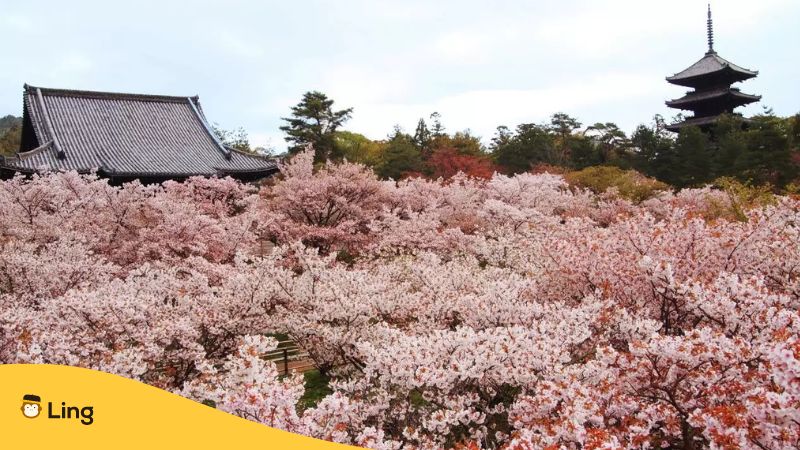
History Of Ninnaji Temple
By the way, did you know the famous Ninnaji Temple used to be called Omuro Imperial Palace (御室御所)? That’s because it was a former imperial residence, where an Imperial Family member would serve as the head priest. While it’s no longer called Omuro, it’s now the head temple of the Omuro School of Shingon Buddhism Sect (修験道御室流). And there’s also another name for the Ninnaji Flower Festival – Omuro Flower Festival (御室花祭り)!
This former Kyoto Imperial Palace faced so many wars and fires throughout history that most of the original buildings on the temple grounds are long gone. Still, the oldest ones that survived date back to the early 1600s, the start of the Edo Period. That’s more than 400 years ago!
These buildings include the main hall Kondo (金堂), which literally translates to “Golden Hall,” the Kannon Hall (観音堂), which is dedicated to Kannon (観音), the Goddess of Mercy, the Niomon front gate (仁王門), the Chumon inner gate (中門), and last but not least, the five-storied pagoda (五重塔).
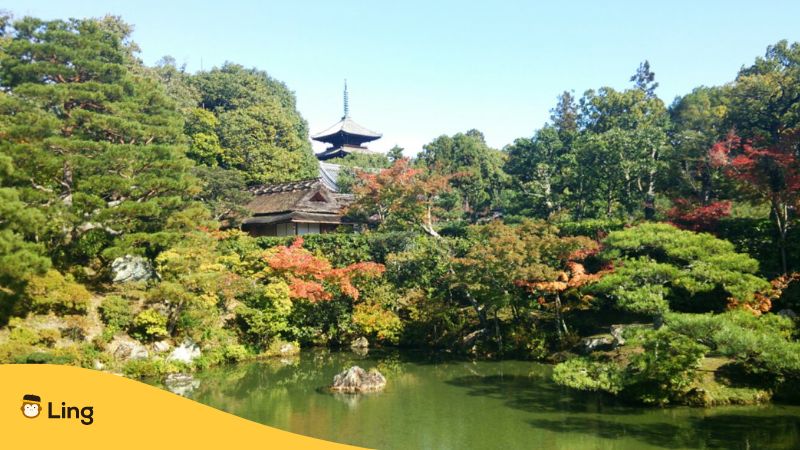
How To Celebrate Ninnaji Flower Festival
Pay A Visit To Goten Palace
When visiting Ninnaji Temple for the flower festival, make time to explore the majestic Goten Palace (御殿) on site. This historic building features imperial architecture resembling an ancient royal residence, as it once housed the head priest.
Instead of the modern push-and-pull doors that we’re used to, it features traditional Japanese sliding doors called Shoji (障子) and Fusuma (襖) with watercolor paintings on them. When visiting, also note how the translucent shoji allows light into the Japanese-style rooms while the opaque fusuma provides privacy.
The palace is also encircled by a serene rock garden with a crystal clear pond dotted with a few Buddhist statues. Gaze into the water to see the statue’s reflection shimmering like a mirror…or just check yourself out ala Mulan!
Be Awestruck In The Reihokan
A rare treat at Ninnaji is entering the historic Reihokan (霊宝館) hall, which is open to the public just thrice yearly, including spring. Translating to “Treasure House,” it showcases the temple’s art collection—a staggering 47 pieces are national treasures!
When you walk in, you’ll be greeted by the temple’s impressive art collection—47 of which are classified as national treasures! Art exhibitions featuring the spectacular works of contemporary Kyoto artists are also held from time to time.
Explore The Nearby Ryoanji Temple
Beyond Ninnaji lie more serene sites like Ryoanji Temple (龍安寺), just a 10-minute walk away. Originally an aristocratic villa during the 12th-century Heian era, it later became a zen temple with sprawling rock gardens. Whereas Ninnaji falls under the Omuro branch of Buddhism, Ryoanji belongs to the Myoshinji school and Rinzai zen tradition.
Easy Japanese Phrases For Ninnaji Flower Festival
Here are some easy Japanese phrases that you can use for this incredible event.
| English Translation | Japanese Script | Romanization |
|---|---|---|
| I want to go to the Ninnaji Flower Festival. | 仁和寺花祭りに行きたいです。 | Ninaji hanamatsuri ni ikitai desu. |
| It’s a beautiful festival, isn’t it? | 綺麗な祭りですね。 | Kireina matsuri desu ne. |
| The cherry blossoms are blooming! | 桜が咲きました! | Sakura ga sakimashita! |
| I love spring season in Japan. | 私は日本の春が大好きです。 | Watashi wa nihon no haru ga daisuki desu. |
| The temple atmosphere is so calming. | お寺の雰囲気はとても穏やかです。 | Otera no funiki wa totemo odayaka desu. |
Ready To Experience The Ninnaji Flower Festival?
Ready to buy a ticket to Kyoto and see the cherry blossoms bloom? WAIT! I urge you to work on your Japanese skills before you go. And for this, I recommend downloading the Ling app, and you’ll be good to go. It’s filled with useful phrases for travel but also notes on Japanese grammar and vocabulary through fun-filled and bite-sized lessons!
All the best on your Japanese language learning journey, Ganbatte (頑張って)!
